Hydrangeas have been popular ornamental garden plants with blooms in various colors, including white, shades of blue and pink, maroon, red, and pale green. Some hydrangeas have large, round flower heads, while others have smaller, flatter, and delicate flowers, along with varying foliage shapes. The hydrangea is considered a shrub & blooming in spring and summer. The hydrangea grows quickly, reaching up to 15 feet in height, and often fills in space in just one summer.
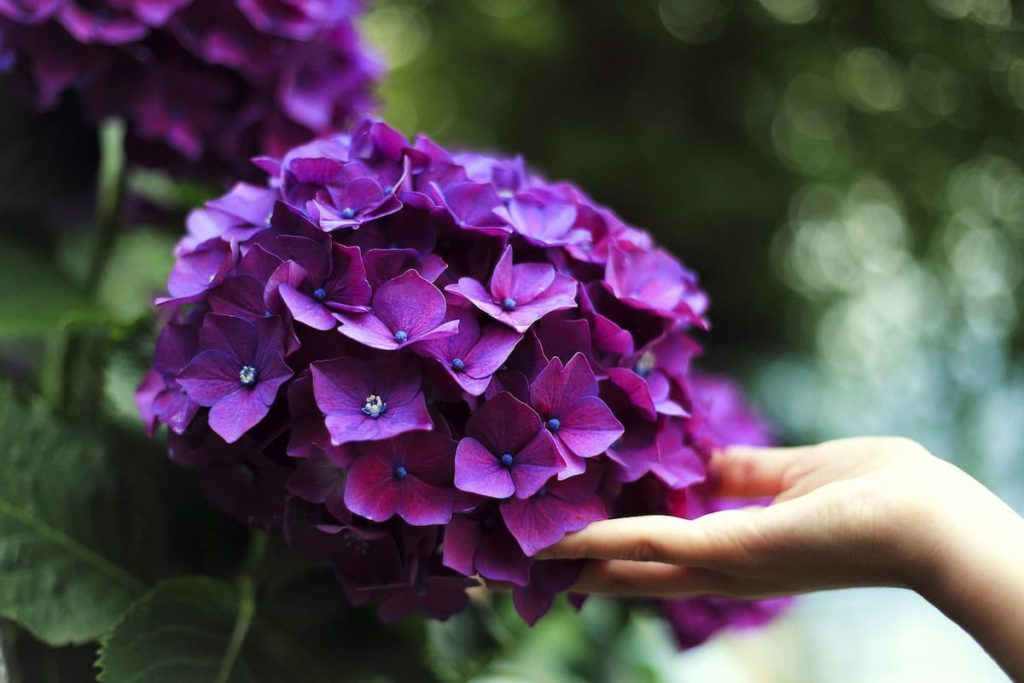
With flowers starting in spring and generally will last throughout summer into early fall, hydrangea flowers can be the foundation plant of the garden. These elegant plants are very easy to cultivate, tolerate almost any type of soil, and can produce abundant blooms. Colors beguile with blue, vibrant pink, white, lavender, and rose blossoms, and sometimes all flowers bloom on the same plant. Hydrangeas are excellent for various garden sites, from group plantings to shrub borders to containers.
How to plant and care for hydrangeas
Soil and sunlight requirements to plant hydrangeas
Knowing where to plant hydrangea shrubs is the most important foremost step. Most hydrangeas will grow well in fertile, well-draining soils with plenty of moisture. Hydrangeas grow well and bloom in soil with pH ranges between 6.0 to 6.2. Add compost to increase nutrients to the poor soil. Soggy and poorly draining soils can cause root rot, and the plant will die. Many people will plant hydrangeas in beds next to their homes or fences. Generally, hydrangeas prefer partial sun, and they need to be exposed to sunlight in the morning, followed by afternoon shade to protect them from the hot midday sun.
This requirement of partial exposure to sunlight is especially true for the Bigleaf hydrangea, whose large leaves are prone to wilting. Some varieties are more tolerant of the full sunlight. Space hydrangeas anywhere with a spacing of 3 to 10 feet apart, depending on the type. Plants should be spaced based on their expected size at maturity. The best spot to plant these plants is in a shaded area with sunny mornings and shady afternoons. Avoid planting directly underneath trees, leading to competition for water and nutrients. High winds can damage leaves and destroy flowers.
Types of the hydrangea plants
Of the many species of hydrangea, the following are the most commonly used as ornamental shrubs. Most commercially-available hydrangea cultivars are derived from a relatively few species of the hydrangea genus.
Hydrangea macrophylla
The common type of hydrangea is a hydrangea macrophylla, also called bigleaf or French hydrangea. These plants are again categorized as mophead, lacecap, and mountain hydrangea. This species commonly grows six to ten feet in height and wide and has six-inch leaves. Bloom color will be changed according to soil pH. Acidic soil will produce blue blooms, while an alkaline soil will produce pink blooms.
In case you missed it: Onion Farming in Tamilnadu: A Helpful Production Guide for Beginners
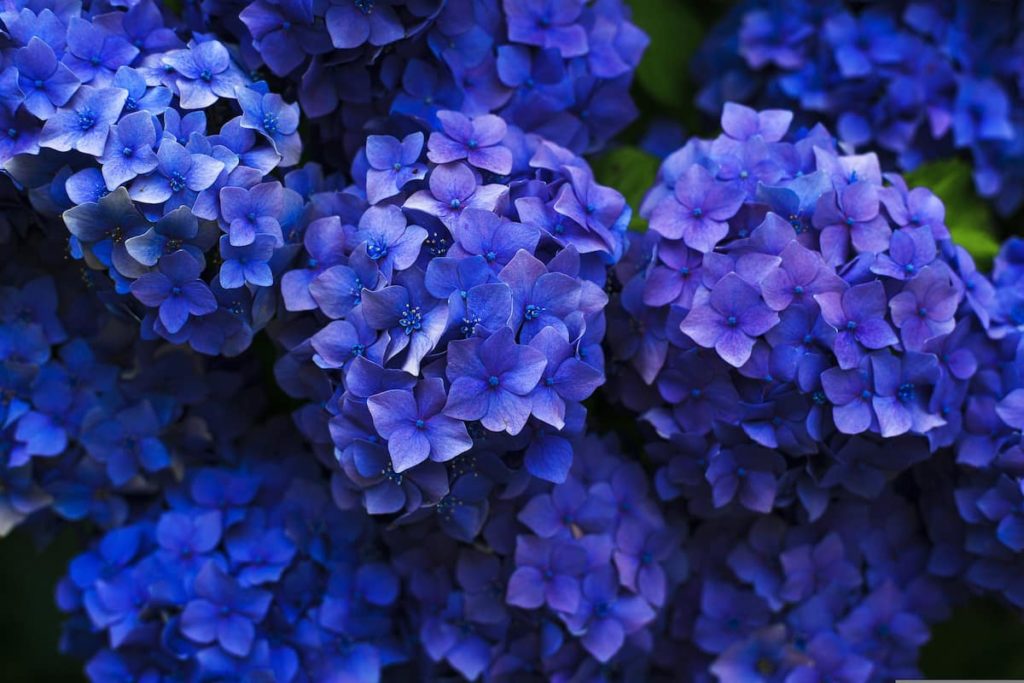
Hydrangea arborescens
This plant is also known as smooth hydrangea. This plant produces huge, densely packed 12-inch flowers the shrub produces in abundance. However, the sturdy stems on this plant will not allow the flowers to flop into the mud. One potted plant can make a gorgeous anchor on the summer border or several plants for a showy hedge. These shrubs can reach around three to five feet tall and produce white to pink flowers. Buds will set on new stems in spring.
Hydrangea quercifolia
This variety is commonly called oakleaf hydrangea. It produces a season-long spectacle of colors of flowers, starting white and gradually changing to pink, and then the foliage joins the display in autumn with a pleasant red showing. These plants bloom on old wood; oakleaf hydrangeas require a garden to prevent winter damage that affects future growth. This plant reaches around seven feet in height with white to purplish-pink flowers. Its leaves look like an oak tree, and buds are set mid-summer through fall.
Hydrangea paniculate
This type is also commonly called panicle hydrangea. The blooms of this species are cone-shaped rather than round or flat. For many cultivars, the flowers start white and gradually change to light pink and later will change to a darker pink as they mature. This plant will grow quite large if left unpruned; panicle Hydrangeas usually grow up to 8-20 feet in height and 6-8 feet wide. They may be grown as single-stemmed specimens or as multi-stemmed shrubs. This species blooms on new stem growth.
Hydrangea anomala
Hydrangea anomala, also known as climbing hydrangea, is a useful low-maintenance climbing shrub perfectly suited for a shady or north-facing wall. It is slow to get going, often making little new growth in the first few years. The stems will cling to the walls by adventitious roots. Hydrangea anomala grows in moist and well-drained soil in shade or partial shade. Plants may grow well in sunnier locations, but the flowers do not last as well as in shadier sites.
Methods to propagate hydrangeas
Propagating hydrangeas from seeds
Hydrangeas produce seeds from their enormous blooms, which are very small, and these seeds in the size of cracked pepper. Once the shrubs bloom with flowers, allow 8 to 12 weeks for the flower to start to fade and dry. It is the ideal time to clip the flower heads and place them in a brown paper bag. Store these flowers in the bag for 3-7 days to finish drying out. Close and shake the bag. That should cause the seeds to separate from the florets.
Surface sow the seeds in a container filled with potting soil. Scatter the seeds simply on top of the soil, and leave the seeds alone after that. Do not bury the seeds or mix them with the dirt. Place the container in a sunlight spot and protect them from the wind. This process will take around 14 days. Once the seedlings start growing from seed, transplant your seedlings into new pots.
Propagating by rooting branches directly in the soil
- Select a healthy branch close to the ground level.
- Trim leaves from the part where the branch touches the soil.
- Do separate the branch off the mother plant. Dig a hole about 2 inches deep
- Bend down the branch without breaking, and ensure a large piece of it touches the soil.
- Cover the branch with soil where it touches the ground
- To keep the branch in the soil, secure the branch by weighing it down with a brick or rock.
- Water the branch regularly while watering the mother plant.
- Remove the weight occasionally and gently tug on the branch to see if it has rooted.
- Once it has rooted, clip the branch from its parent plant and transplant it to a new container
In case you missed it: How to Start Tomato Farming in Africa: Production Guide for South Africa, Egypt, Nigeria, Kenya, Ethiopia, and Zambia
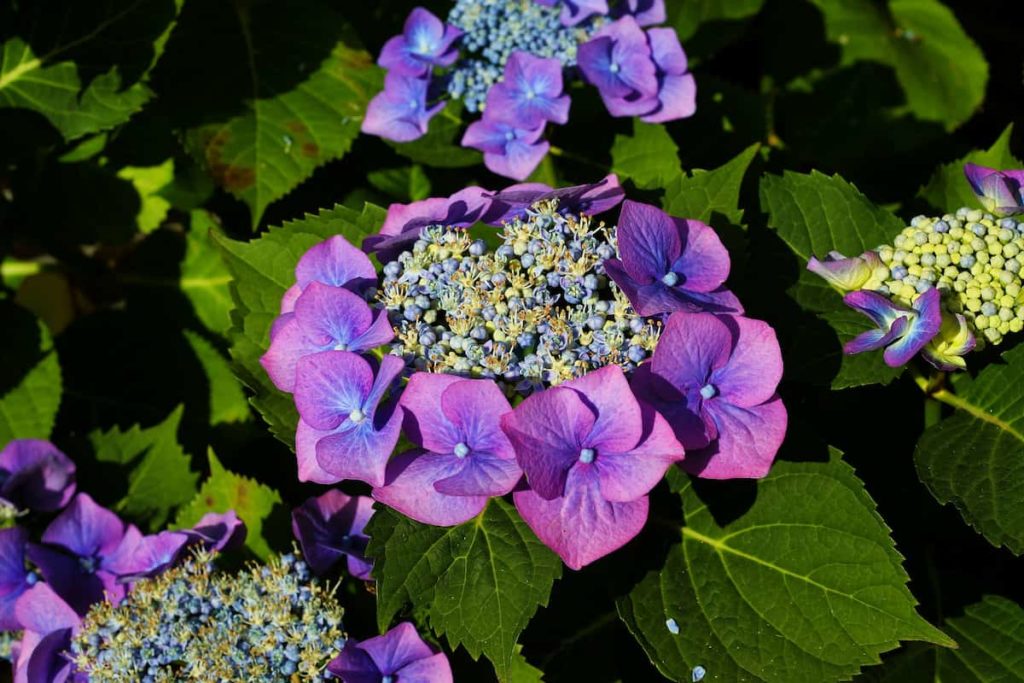
Plant propagation from cuttings in the soil
- select a healthy stem at least six-to-eight inches long that does not have a flower
- With a Clean, sharp pruner, cut the stem below a leaf node.
- Strip off the bottom leaves, but keep the top set of leaves.
- Dip the cutting end of the branch in the rooting hormone.
- Plant the cutting end of the branch into a small eight-to-ten inch pot filled with damp potting soil.
- Create a mini-greenhouse for the pot or container by covering it with a plastic bag. Cut a couple of small holes on top of the bag so the cutting can breathe.
- Keep the pot away from direct exposure to sunlight and the soil slightly damp.
- Once the roots are developed, transplant the cutting to establish a strong root system.
Hydrangea water propagation
- Choose a healthy branch from the well-established plant and separate it.
- Dip the cutting end of it in a glass so the stem sits in the water. Ensure that the leaves do not sit in the water.
- Add some rooting hormone for developing roots faster.
- Change out the water every few days.
- Expose this glass with the branch to adequate sunlight.
- Monitor the progress of the rooting.
- Once enough roots are developed, please take out the branch from the water solution and plant it in a pot containing potting soil.
Planting hydrangeas
Hydrangeas grow well in moist soil, so if the soil is light, bulk it up with moisture-retaining organic matter such as well-rotted manure or compost before planting. Water the plant well an hour before planting. Do not plant a hydrangea deeper than it was in its previous pot. Use mulch after planting. Keep the plant well-watered throughout its first spring and summer. The basic steps involved while transplanting the plants include,
- Pull gently and separate the hydrangea plant from its container and inspect the root ball.
- Tease free the roots if the plant is especially root bound and snip off any dead or rotting parts.
- Dig a hole deep as the root ball. The plant base should be level with the top of the planting hole.
- Place the plant carefully in the hole, fill it half full with soil, and water it generously. After the soil absorbs the water, fill the rest of the hole with the soil.
- Water thoroughly once again after filling the soil in the pot.
Pruning of hydrangeas
The foremost step of pruning hydrangeas is identifying the hydrangea variety, which determines how, when, and even if it needs pruning. Pruning hydrangeas is divided into two groups.
Group 1
The hydrangea plants that bloom last year’s growth or old wood should be pruned in late summer. The plant varieties that require pruning in late summer are
- Oakleaf hydrangeas
- Bigleaf hydrangeas
- Mountain hydrangeas
- Climbing hydrangeas
Group 2
The hydrangea plants bloom on new growth or wood and should be pruned in late winter to early spring. The plant varieties that require pruning in late winter are
- Smooth hydrangeas
- Panicle hydrangeas
Two varieties, reblooming and remontant, bloom on old and new wood. These types do not require pruning. Cut the branches if they are dead, diseased, damaged, or crossing branches for these varieties. Below are the caring steps that need to be followed while pruning hydrangeas includes,
- Trim two or three of the oldest and weakest stems at the base of the plant to encourage new growth with better blooms.
- Using secateurs, remove old flowerheads carefully just above the buds.
- If the bigleaf hydrangea has been neglected and has lots of tangled branches, prune and cut the stems to the base of the plant.
In case you missed it: Emerging Trends in Agriculture in India: A Guide to Future of the Farming
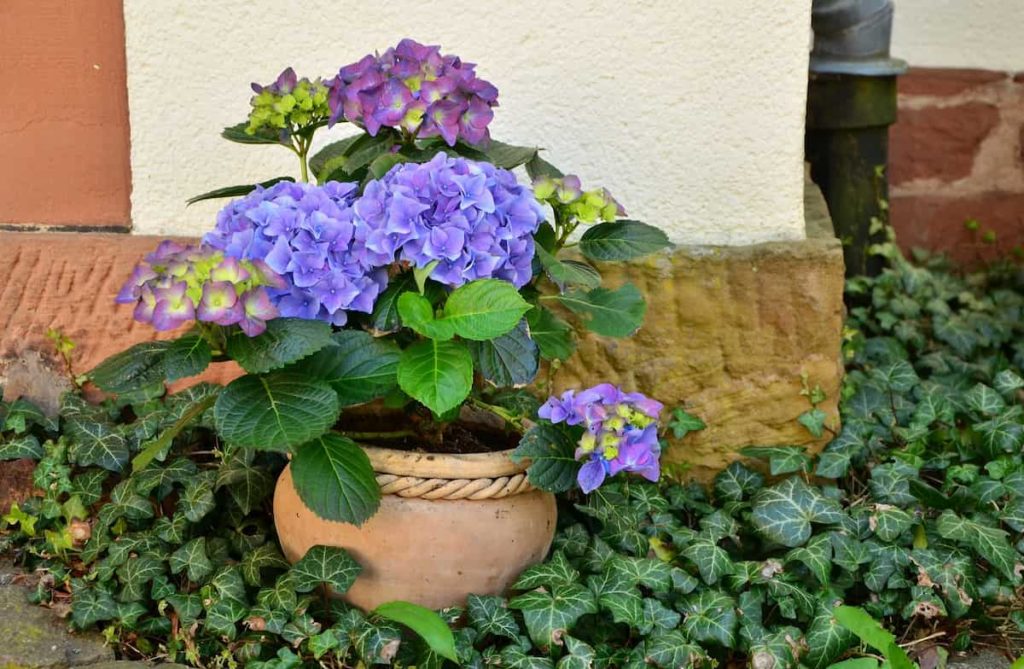
Hydrangea care
Light
These plants should be exposed to a minimum of four hours of bright sunlight to produce strong and healthy stems. However, six or more hours will be best. All hydrangeas can have the ability to handle some shade, but the timing and shade type is important. Please keep them in full shade during the hottest part of the day, as long as they get some morning sun. However, if they are not getting enough sun, they do not bloom flower as much, and the plant stems tend to be weaker and floppier.
Soil
Hydrangeas generally tolerate many soil types but grow well in fertile, humus-rich soil. In Hydrangea macrophylla, flower color can be changed by modifying the soil pH. Acidic soil with a 6.0 pH value or lower will produce blue flowers, and neutral to alkaline soil with a pH value of 7.0 or higher produces pink blooms. The soil should be well drained to avoid waterlogging, which may cause root rot.
Watering
Hydrangeas need plenty of water for the first year or two after planting and during drought. Water them at an inch per week rate throughout the growing season. It is better to deeply water three times a week than sprinkle water in a shallow manner. This deep watering encourages root growth.
Bigleaf and smooth hydrangeas need more water, but almost all varieties benefit from consistent moisture. Leaves will be wilted if the soil is too dry, and a lack of water will hamper flowering. Water deeply using a soaker hose to keep moisture off the flowers and leaves. It is best to water in the morning to prepare hydrangeas for the day’s heat and avoid disease.
Mulching
Like many other plants, hydrangeas benefit from the protection of a thick layer of mulch. Spread and maintain the mulch properly. The hydrangeas will have better growth and nicer blooms. Add organic mulch underneath the hydrangeas to help keep the soil moist and cool, add nutrients over time, and improve soil texture.
Apply a 2-inch layer of mulch in spring just as the leaf buds start opening. Mulching will help reduce weeds, retain moisture, and give your beds a clean look. Pine bark, compost, shredded mulches, and pine needles are all good choices depending on availability in your region.
In case you missed it: Indiana Vegetable Planting Calendar/Guide (IN): Month Wise, Fall, Winter, Spring, Summer, Zone 5, and Zone 6
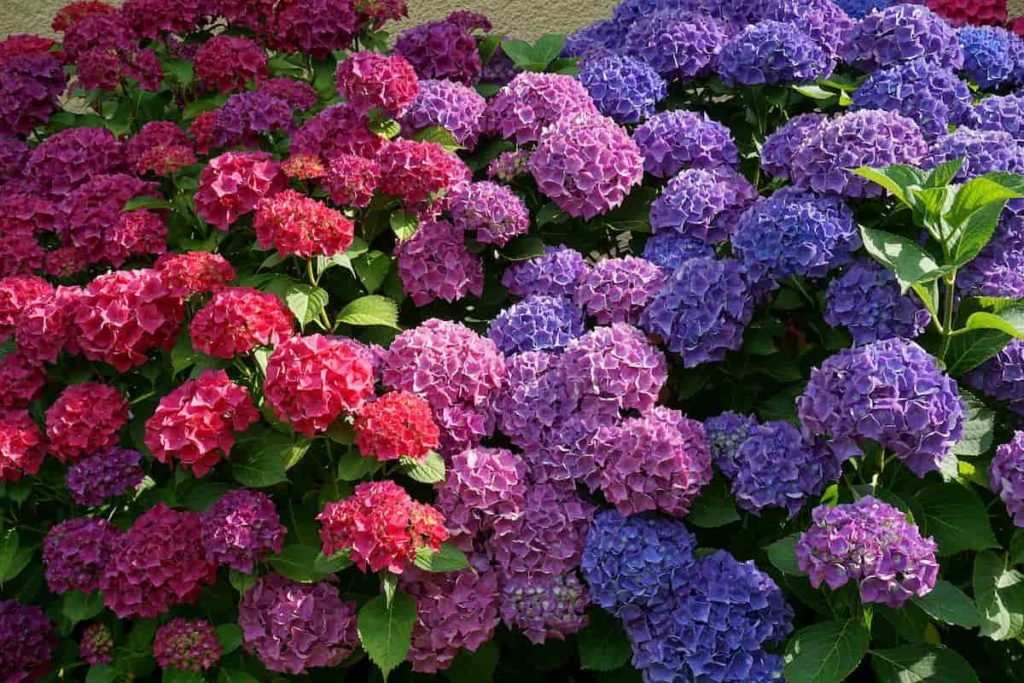
Fertilizing
Fertilizing will improve the power and intensity of blooms, especially when the fertilizer is fed at the right time. For best results, hydrangeas need fertilizing at two critical times. The first is just before or as they are coming out of dormancy in early spring. The second time to fertilize the hydrangeas is right before they begin to bloom and flower. Apply fertilizer based on the specific hydrangea varieties. Each variety has different requirements and will get benefit from different application timing.
- Common variety, bigleaf hydrangeas can be fed with several light fertilizer applications in March, May, and June.
- Oakleaf and panicle hydrangeas grow well with two rounds of fertilizers in April and June.
- Smooth hydrangea plants only require fertilization once, in late winter.
Protect against pests and disease
Hydrangeas commonly do not get affected by pests and diseases, but when the flowers look less than stunning, it is hard not to panic. Leaf spots, bight, wilt, and powdery mildew appear on hydrangeas. Pests are not common but can appear when plants suffer from stress. Possible pests affecting these plants include aphids, leaf tiers, and red spider mites.
To control and prevent many diseases, use a soaker hose or spray nozzle to water the plants. And water in the morning, so water on the leaves has a chance to dry if any. And Additionally, many problems are a result of lack of water. If flowers turn brown and die quickly or leaves have brown, brittle spots around the edges because of underwatering.
How to revive a hydrangea plant
Hydrangeas are beautiful plants with a large assemblage of flowers. The flowers come in various colors and will add vibrance to your place. However, sometimes, The plant undergoes a wilting or dying. Dying hydrangea can be revived after understanding what is causing harm Most common reasons why Hydrangea die and needs reviving are:
- Drought
- Exposed to too much sunlight
- Frost damage
- Shock during transplanting
- Root rot
- Planted in a small pot
- Overfertilization
- Mildew
The below steps need to be necessarily followed to revive a dying hydrangea plant
- Water the soil around the hydrangea generously without getting flowers and leaves wet.
- Apply a mulch around your hydrangea with a one-inch layer of compost, leaf mold, or well-rotted manure.
- Try to reduce the amount and use of fertilizer.
- Transplant the hydrangea plant to a spot where the plant can get sunlight during the morning and keep away from afternoon sun heat.
- If the plant is root bounded, transplant it to a new pot bigger than the previous pot.
How often do water hydrangeas?
Hydrangeas are classified as plants that need a lot of water. They need a lot of water while they are becoming established. They are not considered drought-tolerant plants, so they will always need some supplemental watering where other shrubs and perennials may not. The Magical garden hydrangea loves moist soil, and these hydrangeas in pots need regular water, and so do those in the ground. This regular watering is especially important during warm periods. Giving the plant plenty of water a few days a week rather than a little every day is better.
Ensure to keep the flowers dry when watering. On warm days, early morning or evening is the best to water. Once established, hydrangeas should be watered about one inch per week. The water should be evenly distributed at the roots and never over the top of the plant. Watering top down will encourage fungal disease and potentially harm the plant. The plants need to be watered more frequently during periods of extreme heat.
In case you missed it: How to Grow Snake Plants: A Guide to Planting and Care
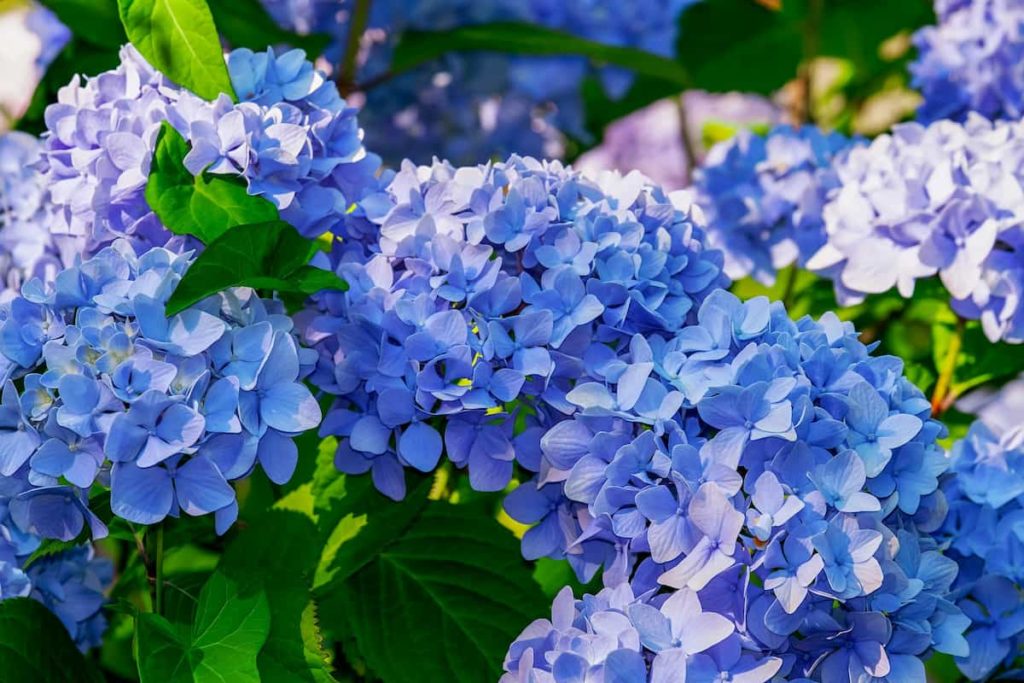
Is hydrangea perennial?
Perennial plants grow back every spring. Perennials bloom faster than others. Most people like to plant perennials because they can have an authentic look in their garden Spring after Spring. Hydrangeas are considered perennials; they come back every year once planted if the plant is not beaten down too much by the winter months. Once planted, as long as they are properly cared for, hydrangeas come back every year.
These plants will drop seeds that will slowly germinate and reproduce for the next season. It allows the gardener to plant once at the beginning of the planting season and need not worry about seeds for the next year. Hydrangeas live up to 50 years if properly cared for; although they may not bloom yearly, they are still viable plants.
Affecting factors make hydrangeas grow faster
Hydrangeas will produce large and round flower heads, while other plants have a smaller, flatter, and more delicate flowers with varying foliage shapes depending on the species. Hydrangea shrubs will have time to establish a healthy root system if planted in the fall or early spring. Hydrangea plants are rapid growers, averaging two feet or more of growth per year. Hydrangeas are fast growers. Proper care, including enough water, sunlight, and fertilizer, can result in the plants speeding up the growing process. Pruning helps some types of Hydrangeas grow more quickly.
How long does it take for a hydrangea to grow full size?
Though they are fast-growing shrubs, hydrangeas can take 2-4 years to reach their full size. Some are faster to mature than others. Growing hydrangeas is simple and can thrive in just about any climate. Some grow to about 2 to 3 feet tall and wide, while others grow up to 6 feet tall with a 6-foot spread.
Smaller hydrangea varieties are perfect for compact garden beds, terrace pots, and areas with limited space. They also require less pruning and upkeep because they will not overgrow their planting area. Larger varieties will work well to fill a large landscape area or create a hedge of hydrangeas.
- Management Pests and Diseases in Your Cotton Field
- Sheep Farming Business Plan for Beginners
- Aquaponic Farming at Home: A Step-By-Step Guide
- Profitable Village Farming Business Ideas in 2024
- High-Yield Aquaculture: Fast-Growing Fish for Farming
- Effective Fish Pond Construction Techniques for Beginners
- Irrigation and Water Management in Pineapple Farming
- Blossom to Harvest: Mastering Flowering and Pollination in Papaya Farming
- Pig Fattening Essentials: From Selection to Sale for Beginners
- Raising Wagyu Cattle: A Complete Guide for Premium Beef Production
- Soil Types and Their Water Holding Capacity
- Optimizing Irrigation Schedules for Coconut Groves for Enhanced Yield
- Espresso Your Garden: Coffee Grounds for Healthier Acid-Loving Plants
- The Best Soil Mix for Snake Plants: How to Mix Your Own Snake Plant Soil
- Green Thumb Success: Expert Tips for Cultivating Greenhouse Beans All Year Round
- Bloom All Year Round: The Ultimate Guide to Indoor Hyacinth Care
- Eco-Friendly Gardening: How to Make Liquid Fertilizer from Kitchen Waste
- Ultimate Guide to Grow Anise in Pots: Explore Seed Propagation to Harvesting
- Guide to Raising Chester White Pigs: Discover Breed Facts to Growth Management
- Mastering the Elegance: The Ultimate Guide to Weeping Cherry Tree Care, Planting, and Maintenance
- Ultimate Guide to Planting Garlic in Grow Bags: Growing Strategies for Beginners
- How to Fix Spider Plant Leaf-Related Problems: Natural and Organic Remedies
- 10 Reasons Why Your Tulsi Plant is Shedding Leaves: Home Remedies and Solutions
- Optimizing Growth and Yield: The Advantages of Palm Bunch Ash Fertilizer
- Utilizing Neem Oil Extract as a Natural Pesticide for Hydrangea
- From Soil to Harvest: Various Ways in Which Farmers Can Use AI Tools
- Steps to Encourage and Induce Citrus Flowers: A Comprehensive Guide
- How to Fix Snake Plant Leaf-Related Issues: Natural and Organic Remedies
- Transform Your Garden into a Fragrant Oasis with Raat Ki Rani (Night Blooming Jasmine)
- Discover the Ideal Chicken Breeds for Philippine Farms
- How to Create a Poultry Egg Farm Business Plan for Profits
- Grow Lemon Cucumbers Like a Pro: Insider Techniques for Bountiful Yields
- Ultimate Guide to Caring for Your Pink Princess Philodendron: Tips for Thriving Variegation
- Areca Nut Profit Per Acre: Calculating Yield and Cost of Cultivation
- How Kaveri Chicken is Becoming a More Profitable Breed in Indian Backyards
- Transform Your Barn: 9 Steps to Convert a Horse Stall into a Chicken Coop
